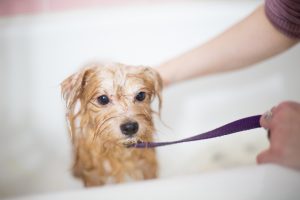
Hey parents! Thinking about adopting a pet for your children? Or perhaps they already own a pet but they don’t know how to care for them properly, leaving you to clean up their mess day after day (yikes!)
Are you going to always be the one who feeds the cat? Are you going to be stuck with dog poop duty? When lines aren’t drawn on who does what, pet care can become a nuisance to daily life and that dissatisfaction can easily build up!
This is why in most households, the responsibility of pet ownership is shared accordingly with children. Children are our home-sitters, and most likely, also their idea to raise a pet first anyway.
If you’re at a stage where you feel that your kids are not ready for such a responsibility, raising a pet would only add on to your long list of chores.
But hey, don’t stress about it! It’s a learning process that we’ll gladly simplify for your children. By the end of this article, we’ll want your child to treat their pets as lifelong companions!
The Fundamentals of Pet Care
Let’s get down to the fundamentals! To fully take charge of a pet’s well-being, you should begin educating your child on the following points about pet care:
- Feeding Pets
- Grooming & Health
- Taking Pets Out for a Walk
- Pet Safety
- Connecting With Pets
1. Feeding Pets

[Unsplash]
Feeding the pet can sound pretty straightforward, but be consistent! Give set times of the days when your child can feed the pet. Depending on the type and breed, they must be catered to accordingly so that they are always satiated.
You may also want to teach your child on possible allergies that the pet might have, as well as the dangers of overfeeding. You wouldn’t want your pet hamster to puff up like a tennis ball in under a month, would you?
Always ensure that the pet receives proper nutrition through a balanced diet, preferably recommended by a professional like your local veterinarian.
2. Grooming & Health

[Unsplash]
If the pet has lots of fur, your child can start with learning how to keep their coat clean and free from mats and tangles; Brush it regularly to remove loose hair, dirt and debris. Regular coat brushing can also help to prevent skin irritations and infections, while improving circulation and healthy coat growth.
Additionally, brushing plays a vital role in preventing fleas that may be present in the fur. For example, by brushing your dog’s coat daily, you can significantly reduce the risk of flea infestations. Fleas often lay their eggs in the fur, and regular grooming helps catch them early, preventing further development.
Don’t forget about bathing the pet! Depending on what the vet recommends, keep the pet clean without over-bathing. We wouldn’t want your child to strip the skin of natural oils by accident!
You can also trim the pet’s nails, clean their ears, and or brush their teeth. These are all preventive methods you take to avoid associating health problems like infections and bad breath.
3. Taking Them Out for a Walk

[Pexels]
That’s right, walks! A big factor to pet care is to constantly keep them active. Just like us, pets need to exercise and move their bodies regularly to avoid obesity and other health problems!
On this front, you should teach your child how to use a leash, and general safety tips while out and about with a pet. Cordon off roads where traffic can be present, and always keep an eye out on the pet.
Be sure to pick up any pet litter, and always be mindful and respectful of public rules so that your child and the pet does not become a public nuisance!
If your child is not ready for an outdoor adventure with their pet yet, they can also play with the comfort of home. As long as they’re not always caged inside, the pet will make do with you until your young ones are ready.
4. Pet Safety

[Pexels]
Pet safety goes both ways. Learning how to interact safely with pets and avoid potential accidents is a part of pet care.
Remind your child to not pull their tails, ears or fur, or climb on them. Always approach pets calmly and gently in the beginning when they’re not used to their new surroundings yet.
To practise general hygiene, tell your child to wash their hands after playing with pets too. You may not know what kind of infections your child may catch!
5. Connecting With Pets

[Pexels]
Now here’s the fun part! Having all that time at home creates an excellent opportunity to get older kids involved in pet training. From a trick as simple as a high-five or rolling over, there are various tutorials online on how to do this with the responsible use of treats.
We want our children to learn empathy building and compassion from an early childhood this way. Encouraging more time with their pets can be the best way for children to develop alongside their pets and form a genuine connection together.
Dealing With Challenges of Pet Ownership

[Pexels]
Of course, we should also be aware of the various difficulties your child may face when taking care of a pet.
Time and commitment is a given, and your child may find it difficult to juggle their responsibility for their pet, with time for their friends and studies. As parents, we should watch over our children so that they’re not burdened with unrealistic expectations.
Another common challenge that children may face when taking care of their pets, is encountering a pet’s behavioural issues. For all sorts of reasons, pets can sometimes develop bad habits like chewing on furniture or baking excessively.
If your child does not have the patience to control their pets, it can be very difficult for them to manage these episodes on their own. Thus if the pet calls for trouble, adult intervention is necessary in order to de-escalate the situation.
A Value Gained Through Experience: Responsibility

[Pexels]
Ultimately, taking care of pets is the ultimate test of responsibility for your young ones. As such, we have provided you with a couple of general pointers to lead them to a good direction in their journey.
To start, explain to your child that taking responsibility for a pet means you are taking care of its physical and emotional needs. Just like humans, pets also need to be fed, bathed, well-exercised and live in a safe, comfortable environment!
Start small with age-appropriate tasks. Before they learn how to clean a litter box, you can teach them to refill a water bowl or brush the fur. As they grow older, naturally assign more complex tasks that they can manage on their own.
Next, establishing a routine or schedule can help get your child into the mindset of commitment. Internalising “to-dos” can help them keep track of the times and days when a pet requires their attention.
Finally, you should praise and reward good behaviour when they’re doing a good job at caring for the pet. Conversely, discourage bad ones to teach them about the consequences of their actions.
Conclusion

[Pexels]
As a pet owner myself, I relate a lot to the joys of raising my adorable Schnauzer. My little partner greets me at the door daily, seeking play and affection with their excited paws on my face.
“How was it today? If you want, I’ll give you a hug!” He seems to tell me every day, reminding me that I am cherished and loved.
A pet’s cuteness never fails to brighten one’s mood after a tiring day of work. Perhaps this is one reason why Singapore is experiencing a steady rise in the pet industry as of recent years. What would our culture with domesticated animals look like in another 10 years? Will our youths become inseparable from these little loyal companions?
With the companionship from raising a pet, comes with its own share of responsibilities. But perhaps there is value in starting young. After all, learning to take care of pets is an important responsibility that also develops empathy, responsibility, and a sense of companionship.
By starting with small tasks and gradually increasing their responsibilities, children can learn to become more independent, taking great care of their pets whilst developing a lifelong love for animals.
To read more about this topic, check out a few of our related articles below.
READ NEXT:
